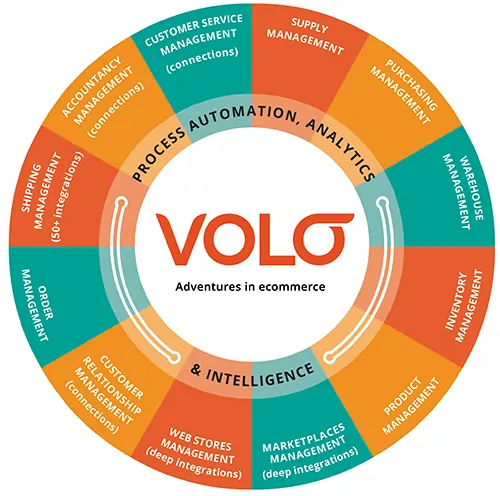Ecommerce ERP
Enterprise Resource Planning for sellers on marketplaces and web stores
Volo Commerce is a comprehensive eCommerce ERP (Enterprise Resource Planning) solution that’s built on two decades of experience, enabling online businesses to manage and streamline their operations across marketplaces and web stores.
At its core, Volo Commerce provides a unified platform that integrates the key aspects of eCommerce operations. It brings together supply, inventory management, order processing, multichannel selling, warehouse fulfillment and other functions into a single, cohesive system, effectively reducing the complexity and workload for online retailers.


- Supply management
- Purchasing management
- Marketplaces management (deep integrations)
- Web stores management (deep integrations)
- Accountancy management (connections)
- Customer Relationship Management (CRM) (connections)
- Inventory management
- Listing management
- Warehouse management
- Order management
- Shipping management (more than 50 integrations)
- Customer service management (connections)
- Plus: Reporting/analytics
With ecommerce ERP systems like Volo’s, as opposed to purely ecommerce, you can efficiently manage your products, listings and orders across multiple marketplaces and sales channels. For sellers who want to scale their business profitably, the benefits of this are improved product availability and breadth, together with increased productivity and optimised processes.
Moreover, Volo Commerce’s advanced analytics and reporting capabilities empower businesses to make data-driven decisions, enabling them to identify trends, optimise pricing strategies and improve overall efficiency. The result is increased profitability and a competitive edge in the rapidly evolving world of eCommerce.

Supply management
What: Manage suppliers, supplier feeds for physical or virtual/drop ship stock, manage supplier prices against orders, even for the same SKU, manage goods in.
Why: Build stronger supplier relationships, get timely, accurate deliveries, improve negotiating power.
Purchasing management
What: Manage purchasing of stock and back orders down to a SKU-by-SKU level, organise by supplier, set rules to auto-create and auto-confirm purchase orders.
Why: Reduce excess inventory and associated holding costs, make significant cost savings and get increased operational efficiency.
Warehouse management
What: Manage multi-location and multi-warehouse layouts and barcode-based tracking of goods from receipt through to dispatch and returns, either paper-based or paperless.
Why: Optimise the warehouse operation based on product demand and size to streamline the put-away, pick, pack, ship and return processes.
Inventory management
What: Automate the synchronisation in real-time of inventory details and stock levels across all channels.
Why: Avoid overselling or underselling, maintain optimum stock levels and keep customers happy with accurate product availability information.
Product management
What: Create, edit and manage product information and listings for multiple channels from one central place, use bulk listing, import and export tools to automate processes.
Why: Save time, increase productivity, make it easier to list more products and ensure product information is up-to-date across different marketplaces and webstores.
Marketplaces management
What: Push product listings up to the different marketplaces, with their different rules, from one interface, use repricing and bulk tools to automate instant price updates.
Why: Maintain resilience with a multi-marketplace presence, stay competitive, respond quickly to buying and market trends, maximising margin and profitability.
Webstores management
What: Push product listings up to the different webstore platforms, from one interface, across multiple online stores, use bulk tools to automate instant price updates.
Why: Complement your marketplace presences, secure your brand and product brand presence, control the complete buying experience, derive better margins.
Customer relationship management
What: Maintain a 360-degree view of your customers, design and automate co-ordinated and targeted marketing programs and promotional campaigns.
Why: Increase reach and impact, identify, attract and retain profitable long-term customer segments and customers.
Order management
What: Design rules-based, paperless or paper-based picking and packing processes, consolidate orders from multiple selling channels into a single processing system.
Why: Reduce handling time, minimise errors, achieve faster processing of orders, improving productivity and enhancing the overall customer.
Shipping management
What: Automate the incorporation of multiple shipping partners through FTP or API connections, automate hundreds of different shipping rules based on many criteria.
Why: Optimise shipping effectiveness, get simpler and faster shipping of orders, keep customers abreast of delivery progress and meet their demanding expectations.
Accountancy management
What: Automate the management and reconciliation of purchase orders and accounts payable, automate the posting of customer sales and accounts receivable.
Why: Improve finance and accounting performance and process, streamline financial analysis and reporting.
Customer service management
What: Centralise customer interactions across all marketplaces and webstores into a single interface, use technology to personalise many of the standard functions.
Why: Respond more quickly, improve issue resolution, deliver a more consistent customer service experience, fostering customer loyalty and trust.
Analytics and reporting
What: Collating, filtering and presenting data across the above twelve areas, providing insight and smart suggestions, with dashboards, reporting and configurable KPI emails.
Why: Minimise the time spent doing manual and custom analysis, make good decisions based on a complete view of the business, to positively impact growth and profits.
Further reading on ecommerce ERP
What is an ERP System/ERP Software?
ERP Software for Small-Medium eCommerce Businesses
Contact us to discuss your ERP requirements.
